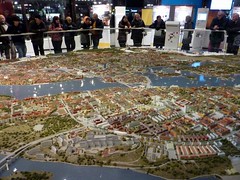March 19, 2011
Cities are the coral reefs of humanity
 Some self advertising: Transhuman Space: Cities on the Edge is now sold on e23. A module for the roleplaying game written by me and Waldemar Ingdahl.
Some self advertising: Transhuman Space: Cities on the Edge is now sold on e23. A module for the roleplaying game written by me and Waldemar Ingdahl.
This has been loooong in coming. Due to a large number of individually trivial causes it has been delayed enormously. But now it is out!
The theme is the city of the future. Not just as a setting for adventures (although they are good for it), but as a concept. Just what are cities good for, and will they survive in a future where people can telepresence from anywhere in the world? Our answer is that cities will remain because they are efficient, they have cultural and economic cluster effects, and they are anchored as memes.
One problem with delays is that science and ideas change. When we wrote it we were influenced by the New Urbanism and Richard Florida. If we wrote it today I suspect we would be using even more Geoffrey West. However, I am still pretty happy with it, and I think our ideas fit with the scaling ideas (basically, West, Bettencourt et al. quantify the economics of scale of cities, and show that they may be driving the rapid growth of super-cities - a rapid growth forcing technological innovation in order to be sustainable). Another experience I have had since writing it is seriously living in a foreign city and culture (OK, slightly foreign - still Northwest European), which shows how small aspects of space and cultural syntax can complicate things - not just people driving (and walking) on the other side of the road, but the different assumptions of what homes and third places are, as well as the parapraxes of infrastructure.
What else is there? A lot deals with how future infrastructure works: when you have AI, nanotech and robots, what does that do to cities? What new kinds of infrastructure do you need? (for example, cities may gain augmented reality layers and relatively cheaply dug tunnel systems for delivery from large-scale fabbing - not all fabbing is going to be local and personal) What are the big threats to such cities? How do people, buildings and cities adapt to changed requirements? (with good telepresence, parks and cafes become more important than offices - so they might eat much of the freed up office space)
A lot of details are about everyday life, the small things that make the game setting alive. Animated or biological graffiti, the AI suburbs, how to deal with free riders in smart transport systems, mothballed buildings and who lives inside, the problems of running a biotech house and what kinds of wood you can order from a vat.
There is also a big section about future Stockholm, a wild and slightly bohemian city acting as a pressure valve for transhumanists inside the staid preservationist Scandinavian societies. Think Berlin after the fall of the Wall - cheap accommodation and slightly rickety infrastructure, lots of counter-culture people that exploit it and make it a happening place to the shock and annoyance of the staid people outside.
All in all, it is not just intended as a rpg sourcebook (although that was of course the main intention) but as a bit of ongoing scenario planning of where we might be going. The cities will remain, but they are going to evolve.
Posted by Anders3 at March 19, 2011 10:51 PM